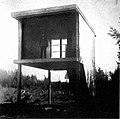Section for socialist development according to the RSFSR state plan
The section for socialist development according to the state plan of the RSFSR , under the leadership of Moissei Ginsburg and Michail Ochitowitsch , dealt with various urban planning issues from 1929 to 1930 and created a number of plans and drafts for model buildings and cities. Other members were Mikhail Barschtsch , Vjacheslav Vladimirov , Georgi Sundblat , Ignati Milinis , Alexander Pasternak , Nikolai Sokolow , G. Savinow and Kirill Afanasjew . The designs are the Desurbanismus attributed and whose main examples.
The section created a basic scheme for a new type of settlement and the unrealized designs for two cities: Magnitogorsk and Seljony Gorod (Green City).
After the dissolution of the section, Moissei Ginsburg's ideas were further developed with a group of architects for the project for the settlement method in the Chernikov industrial area in Bashkortostan , but were not implemented here either.
Projects
Basic scheme of settlement
An essential element of the urban planning ideas of the section was the abolition of the difference between town and country, which Marx also called for. The theoretical basis of the ideas goes back to Mikhail Ochitowitsch, like the whole of desurbanism. He no longer saw the city as necessary because of the new possibilities of transport. Instead, preference should be given to a decentralized type of settlement made up of band cities. Both the residential units and the industries expand linearly so that the path to the workplace is as short as possible. The residential units should be prefabricated and demountable. The supply should be guaranteed through a network of service facilities.
Various designs and plans were made for this basic scheme.
Magnitogorsk (1930)
The plan for Magnitogorsk was drawn up in 1930 by Mikhail Ochitowitsch , Mikhail Perschtsch , Vjacheslav Vladimirov and Nikolai Sokolov . The project consists in the concrete new construction of a city in an industrially relevant location. An attempt was made to combine industrial operations, ore stores , supply industries and agriculture into a uniform system.
The plan provided for eight main settlement bands averaging 25 kilometers in length, which were connected to one another. Each settlement band had a cultural center with clubs, cultural and recreational parks. There was also a central cultural park and a joint administrative and social center.
The plan remained unrealized. Magnitogorsk was instead built by Ernst May and his staff.
Seljony Gorod (1930)
In 1930 a competition was announced for a new city district as a suburb of Moscow . Seljony Gorod ( German : Green City) should be a "city of relaxation".
The competition design, which largely came from Moissei Ginsburg and Michail Barschtsch (employees including Nikolai Sokolow ), deviated from the original specifications and designed a city for 100,000 inhabitants. The settlement band should run along the Jaroslawer Chaussee. At a distance of 200–250 meters there was a band of residential units located above the ground on Pilotis . These residential units should be prefabricated and built together.
Seljony Gorod also had extensive cultural institutions as well as schools and technical teaching institutions.
literature
Selim O. Chan-Magamedow: Pioneers of Soviet Architecture . VEB Verlag der Kunst, Dresden 1983, p. 336-337 .









